Financial Accounting Report: Analysis of Two Companies' Financials
VerifiedAdded on 2020/10/22
|13
|4368
|358
Report
AI Summary
This financial accounting report analyzes the financial statements of Accent Group Ltd and Webster Ltd, focusing on the concept of a reporting entity and its impact on the quality of financial information. The report explores the disclosure of liabilities, including provisions and contingent liabilities, as well as intangible assets and tax expenses. Part 1 defines reporting entities and their importance in providing quality financial information to various users, such as investors and creditors. Part 2 compares the two companies' disclosures of liabilities, noting changes in provisions and total liabilities. Part 3 discusses the disclosure of intangible assets and the importance of financial statements for decision-making and transparency. The report uses IAS 38 to assess the intangible assets and their impact on the financial health of the organizations. The analysis highlights differences in disclosure practices between the two companies and their implications for financial statement users.
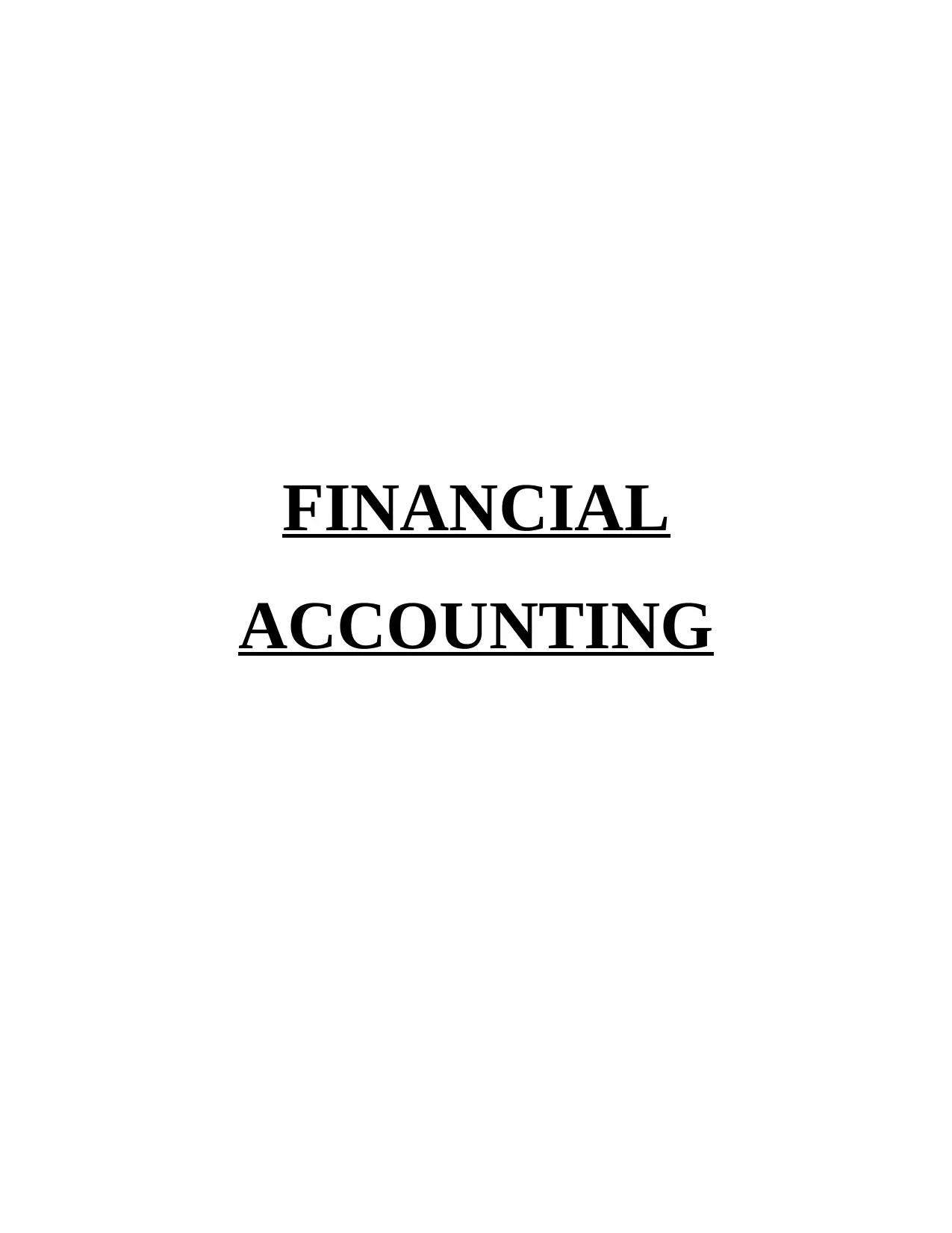
FINANCIAL
ACCOUNTING
ACCOUNTING
Paraphrase This Document
Need a fresh take? Get an instant paraphrase of this document with our AI Paraphraser
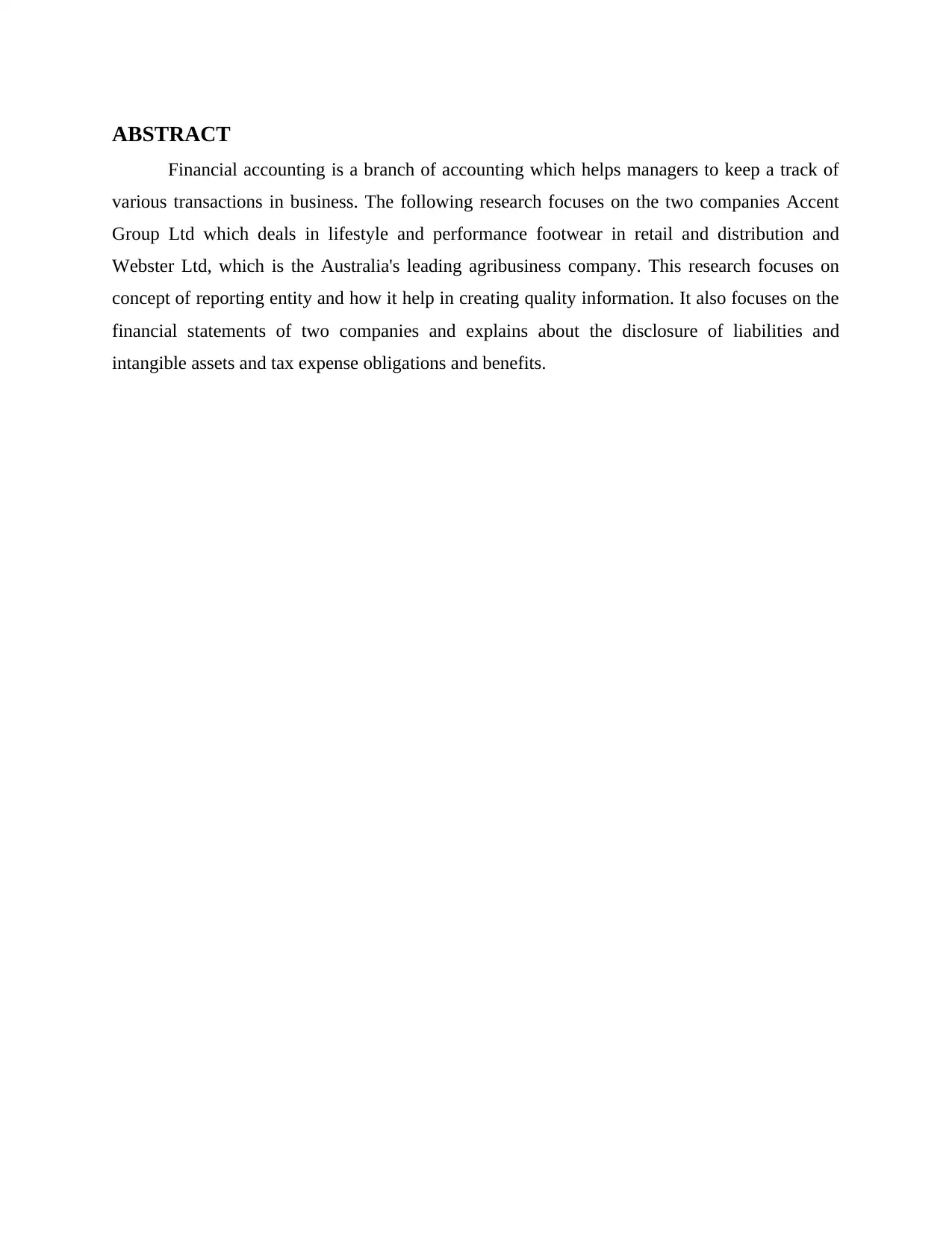
ABSTRACT
Financial accounting is a branch of accounting which helps managers to keep a track of
various transactions in business. The following research focuses on the two companies Accent
Group Ltd which deals in lifestyle and performance footwear in retail and distribution and
Webster Ltd, which is the Australia's leading agribusiness company. This research focuses on
concept of reporting entity and how it help in creating quality information. It also focuses on the
financial statements of two companies and explains about the disclosure of liabilities and
intangible assets and tax expense obligations and benefits.
Financial accounting is a branch of accounting which helps managers to keep a track of
various transactions in business. The following research focuses on the two companies Accent
Group Ltd which deals in lifestyle and performance footwear in retail and distribution and
Webster Ltd, which is the Australia's leading agribusiness company. This research focuses on
concept of reporting entity and how it help in creating quality information. It also focuses on the
financial statements of two companies and explains about the disclosure of liabilities and
intangible assets and tax expense obligations and benefits.
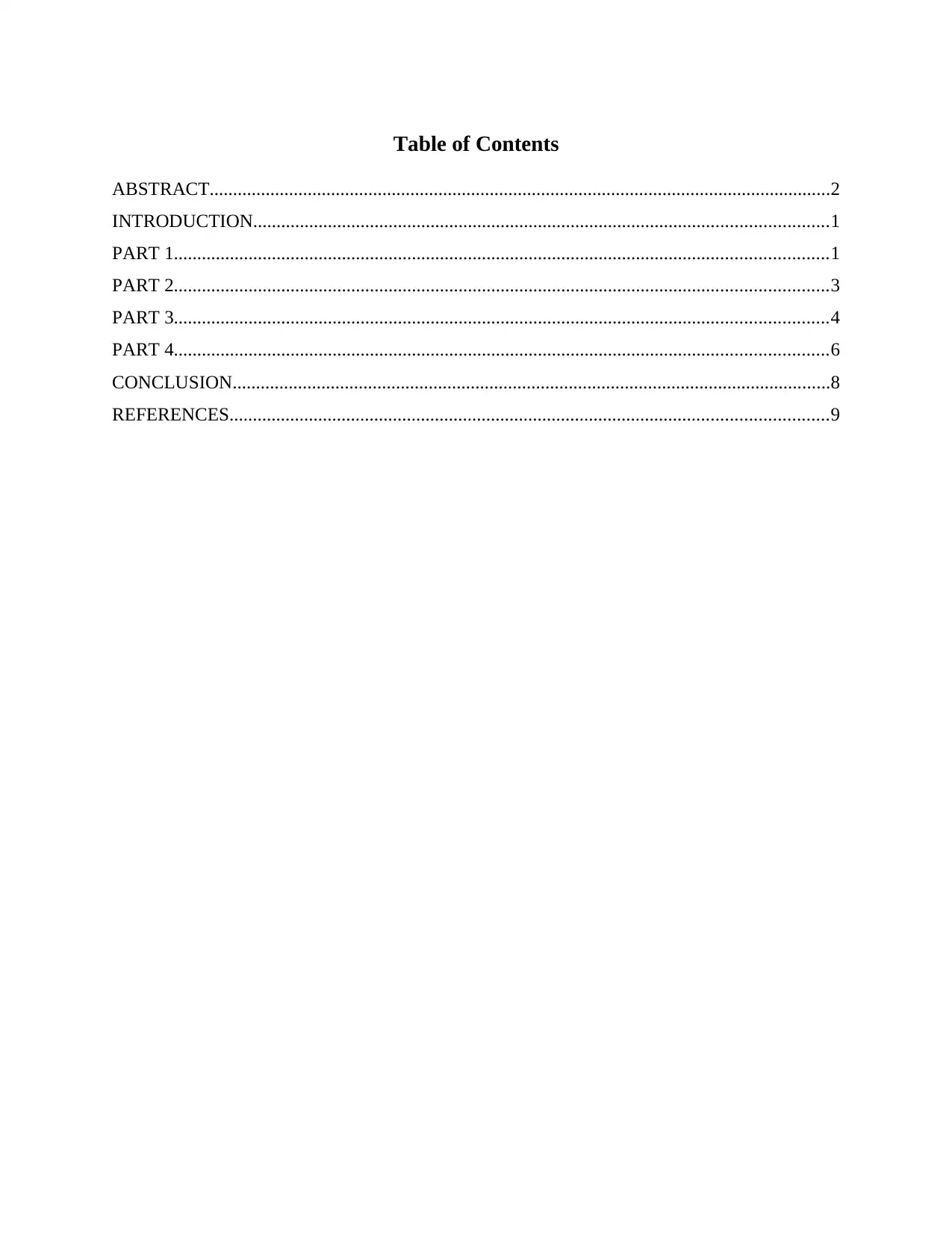
Table of Contents
ABSTRACT.....................................................................................................................................2
INTRODUCTION...........................................................................................................................1
PART 1............................................................................................................................................1
PART 2............................................................................................................................................3
PART 3............................................................................................................................................4
PART 4............................................................................................................................................6
CONCLUSION................................................................................................................................8
REFERENCES................................................................................................................................9
ABSTRACT.....................................................................................................................................2
INTRODUCTION...........................................................................................................................1
PART 1............................................................................................................................................1
PART 2............................................................................................................................................3
PART 3............................................................................................................................................4
PART 4............................................................................................................................................6
CONCLUSION................................................................................................................................8
REFERENCES................................................................................................................................9
⊘ This is a preview!⊘
Do you want full access?
Subscribe today to unlock all pages.

Trusted by 1+ million students worldwide
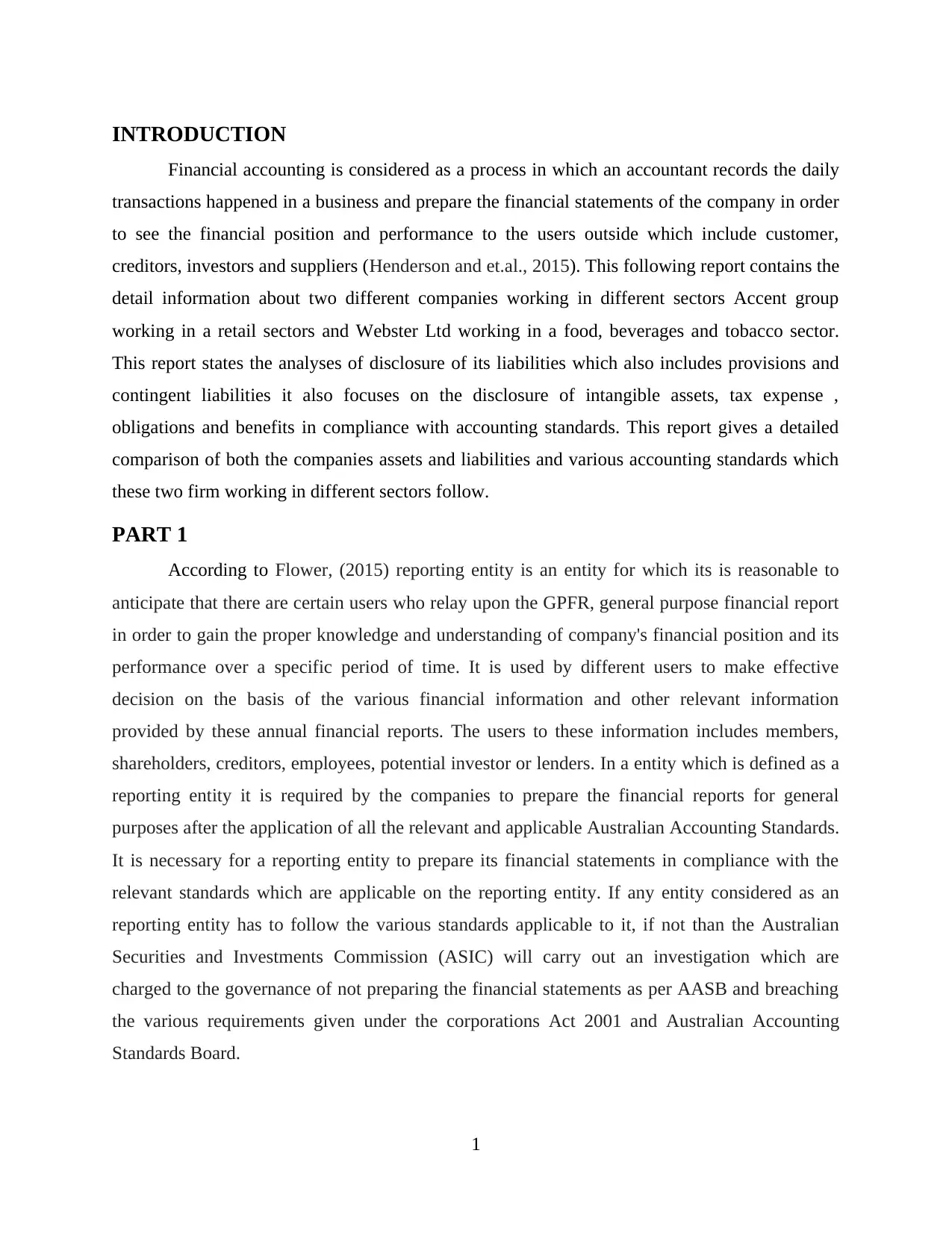
INTRODUCTION
Financial accounting is considered as a process in which an accountant records the daily
transactions happened in a business and prepare the financial statements of the company in order
to see the financial position and performance to the users outside which include customer,
creditors, investors and suppliers (Henderson and et.al., 2015). This following report contains the
detail information about two different companies working in different sectors Accent group
working in a retail sectors and Webster Ltd working in a food, beverages and tobacco sector.
This report states the analyses of disclosure of its liabilities which also includes provisions and
contingent liabilities it also focuses on the disclosure of intangible assets, tax expense ,
obligations and benefits in compliance with accounting standards. This report gives a detailed
comparison of both the companies assets and liabilities and various accounting standards which
these two firm working in different sectors follow.
PART 1
According to Flower, (2015) reporting entity is an entity for which its is reasonable to
anticipate that there are certain users who relay upon the GPFR, general purpose financial report
in order to gain the proper knowledge and understanding of company's financial position and its
performance over a specific period of time. It is used by different users to make effective
decision on the basis of the various financial information and other relevant information
provided by these annual financial reports. The users to these information includes members,
shareholders, creditors, employees, potential investor or lenders. In a entity which is defined as a
reporting entity it is required by the companies to prepare the financial reports for general
purposes after the application of all the relevant and applicable Australian Accounting Standards.
It is necessary for a reporting entity to prepare its financial statements in compliance with the
relevant standards which are applicable on the reporting entity. If any entity considered as an
reporting entity has to follow the various standards applicable to it, if not than the Australian
Securities and Investments Commission (ASIC) will carry out an investigation which are
charged to the governance of not preparing the financial statements as per AASB and breaching
the various requirements given under the corporations Act 2001 and Australian Accounting
Standards Board.
1
Financial accounting is considered as a process in which an accountant records the daily
transactions happened in a business and prepare the financial statements of the company in order
to see the financial position and performance to the users outside which include customer,
creditors, investors and suppliers (Henderson and et.al., 2015). This following report contains the
detail information about two different companies working in different sectors Accent group
working in a retail sectors and Webster Ltd working in a food, beverages and tobacco sector.
This report states the analyses of disclosure of its liabilities which also includes provisions and
contingent liabilities it also focuses on the disclosure of intangible assets, tax expense ,
obligations and benefits in compliance with accounting standards. This report gives a detailed
comparison of both the companies assets and liabilities and various accounting standards which
these two firm working in different sectors follow.
PART 1
According to Flower, (2015) reporting entity is an entity for which its is reasonable to
anticipate that there are certain users who relay upon the GPFR, general purpose financial report
in order to gain the proper knowledge and understanding of company's financial position and its
performance over a specific period of time. It is used by different users to make effective
decision on the basis of the various financial information and other relevant information
provided by these annual financial reports. The users to these information includes members,
shareholders, creditors, employees, potential investor or lenders. In a entity which is defined as a
reporting entity it is required by the companies to prepare the financial reports for general
purposes after the application of all the relevant and applicable Australian Accounting Standards.
It is necessary for a reporting entity to prepare its financial statements in compliance with the
relevant standards which are applicable on the reporting entity. If any entity considered as an
reporting entity has to follow the various standards applicable to it, if not than the Australian
Securities and Investments Commission (ASIC) will carry out an investigation which are
charged to the governance of not preparing the financial statements as per AASB and breaching
the various requirements given under the corporations Act 2001 and Australian Accounting
Standards Board.
1
Paraphrase This Document
Need a fresh take? Get an instant paraphrase of this document with our AI Paraphraser
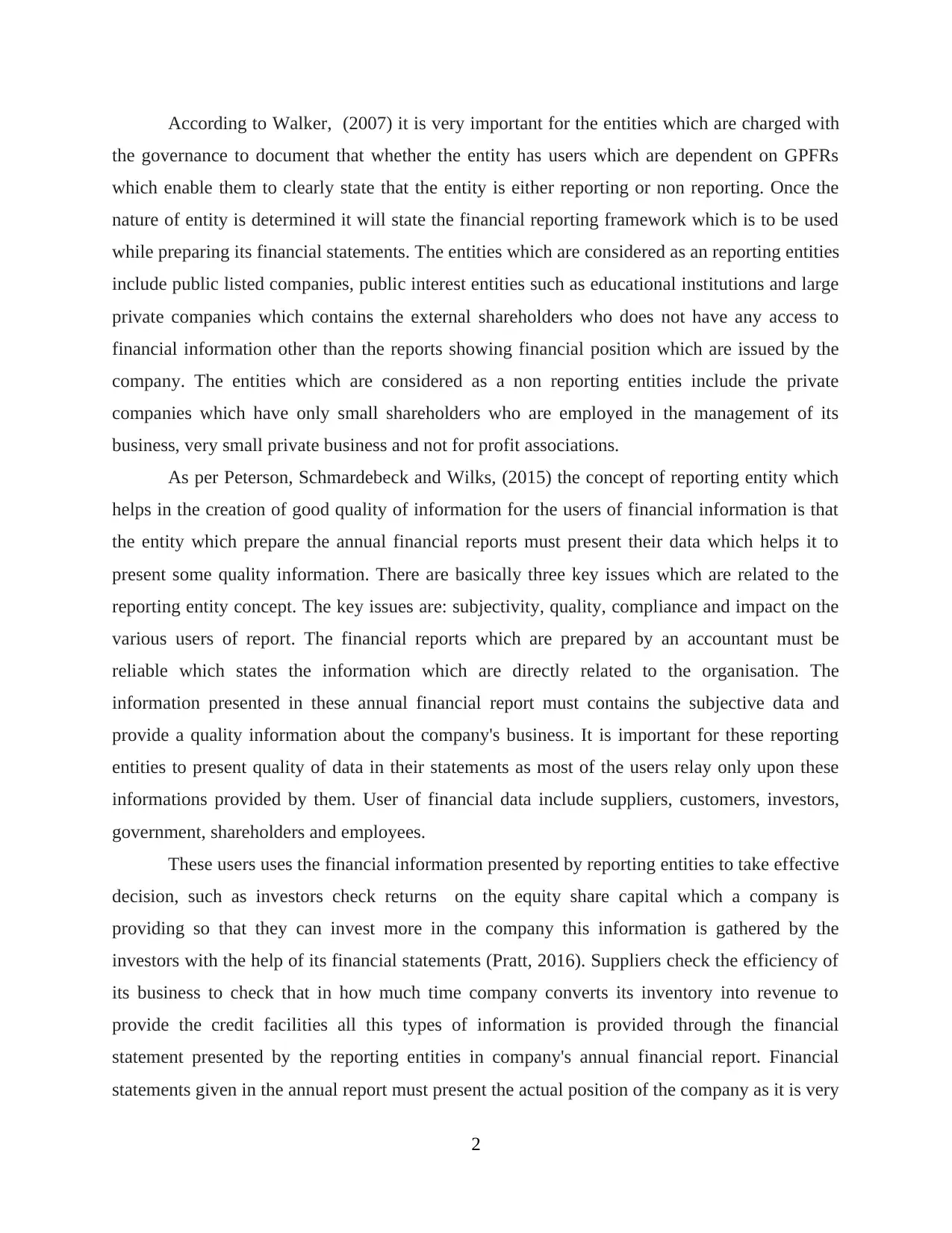
According to Walker, (2007) it is very important for the entities which are charged with
the governance to document that whether the entity has users which are dependent on GPFRs
which enable them to clearly state that the entity is either reporting or non reporting. Once the
nature of entity is determined it will state the financial reporting framework which is to be used
while preparing its financial statements. The entities which are considered as an reporting entities
include public listed companies, public interest entities such as educational institutions and large
private companies which contains the external shareholders who does not have any access to
financial information other than the reports showing financial position which are issued by the
company. The entities which are considered as a non reporting entities include the private
companies which have only small shareholders who are employed in the management of its
business, very small private business and not for profit associations.
As per Peterson, Schmardebeck and Wilks, (2015) the concept of reporting entity which
helps in the creation of good quality of information for the users of financial information is that
the entity which prepare the annual financial reports must present their data which helps it to
present some quality information. There are basically three key issues which are related to the
reporting entity concept. The key issues are: subjectivity, quality, compliance and impact on the
various users of report. The financial reports which are prepared by an accountant must be
reliable which states the information which are directly related to the organisation. The
information presented in these annual financial report must contains the subjective data and
provide a quality information about the company's business. It is important for these reporting
entities to present quality of data in their statements as most of the users relay only upon these
informations provided by them. User of financial data include suppliers, customers, investors,
government, shareholders and employees.
These users uses the financial information presented by reporting entities to take effective
decision, such as investors check returns on the equity share capital which a company is
providing so that they can invest more in the company this information is gathered by the
investors with the help of its financial statements (Pratt, 2016). Suppliers check the efficiency of
its business to check that in how much time company converts its inventory into revenue to
provide the credit facilities all this types of information is provided through the financial
statement presented by the reporting entities in company's annual financial report. Financial
statements given in the annual report must present the actual position of the company as it is very
2
the governance to document that whether the entity has users which are dependent on GPFRs
which enable them to clearly state that the entity is either reporting or non reporting. Once the
nature of entity is determined it will state the financial reporting framework which is to be used
while preparing its financial statements. The entities which are considered as an reporting entities
include public listed companies, public interest entities such as educational institutions and large
private companies which contains the external shareholders who does not have any access to
financial information other than the reports showing financial position which are issued by the
company. The entities which are considered as a non reporting entities include the private
companies which have only small shareholders who are employed in the management of its
business, very small private business and not for profit associations.
As per Peterson, Schmardebeck and Wilks, (2015) the concept of reporting entity which
helps in the creation of good quality of information for the users of financial information is that
the entity which prepare the annual financial reports must present their data which helps it to
present some quality information. There are basically three key issues which are related to the
reporting entity concept. The key issues are: subjectivity, quality, compliance and impact on the
various users of report. The financial reports which are prepared by an accountant must be
reliable which states the information which are directly related to the organisation. The
information presented in these annual financial report must contains the subjective data and
provide a quality information about the company's business. It is important for these reporting
entities to present quality of data in their statements as most of the users relay only upon these
informations provided by them. User of financial data include suppliers, customers, investors,
government, shareholders and employees.
These users uses the financial information presented by reporting entities to take effective
decision, such as investors check returns on the equity share capital which a company is
providing so that they can invest more in the company this information is gathered by the
investors with the help of its financial statements (Pratt, 2016). Suppliers check the efficiency of
its business to check that in how much time company converts its inventory into revenue to
provide the credit facilities all this types of information is provided through the financial
statement presented by the reporting entities in company's annual financial report. Financial
statements given in the annual report must present the actual position of the company as it is very
2
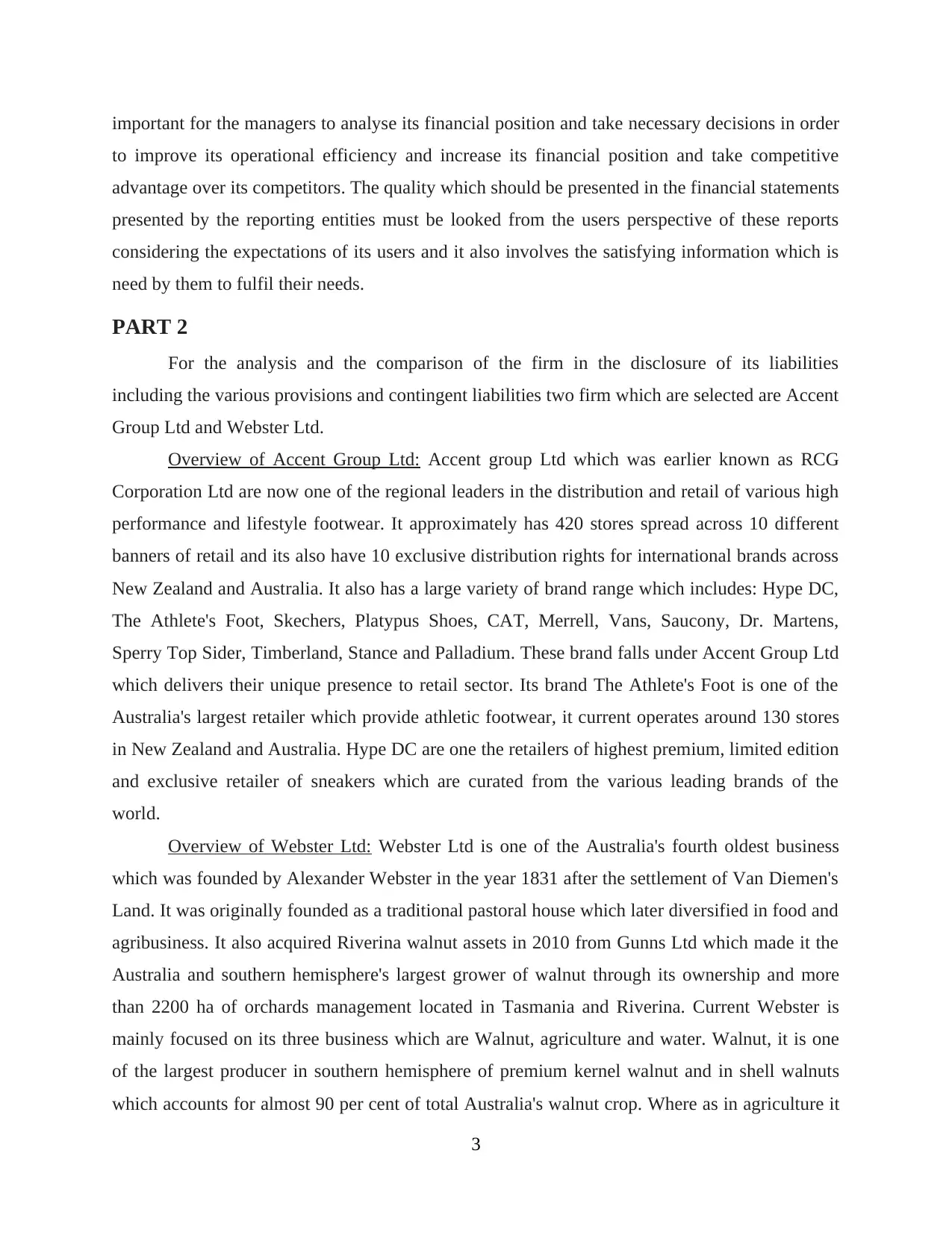
important for the managers to analyse its financial position and take necessary decisions in order
to improve its operational efficiency and increase its financial position and take competitive
advantage over its competitors. The quality which should be presented in the financial statements
presented by the reporting entities must be looked from the users perspective of these reports
considering the expectations of its users and it also involves the satisfying information which is
need by them to fulfil their needs.
PART 2
For the analysis and the comparison of the firm in the disclosure of its liabilities
including the various provisions and contingent liabilities two firm which are selected are Accent
Group Ltd and Webster Ltd.
Overview of Accent Group Ltd: Accent group Ltd which was earlier known as RCG
Corporation Ltd are now one of the regional leaders in the distribution and retail of various high
performance and lifestyle footwear. It approximately has 420 stores spread across 10 different
banners of retail and its also have 10 exclusive distribution rights for international brands across
New Zealand and Australia. It also has a large variety of brand range which includes: Hype DC,
The Athlete's Foot, Skechers, Platypus Shoes, CAT, Merrell, Vans, Saucony, Dr. Martens,
Sperry Top Sider, Timberland, Stance and Palladium. These brand falls under Accent Group Ltd
which delivers their unique presence to retail sector. Its brand The Athlete's Foot is one of the
Australia's largest retailer which provide athletic footwear, it current operates around 130 stores
in New Zealand and Australia. Hype DC are one the retailers of highest premium, limited edition
and exclusive retailer of sneakers which are curated from the various leading brands of the
world.
Overview of Webster Ltd: Webster Ltd is one of the Australia's fourth oldest business
which was founded by Alexander Webster in the year 1831 after the settlement of Van Diemen's
Land. It was originally founded as a traditional pastoral house which later diversified in food and
agribusiness. It also acquired Riverina walnut assets in 2010 from Gunns Ltd which made it the
Australia and southern hemisphere's largest grower of walnut through its ownership and more
than 2200 ha of orchards management located in Tasmania and Riverina. Current Webster is
mainly focused on its three business which are Walnut, agriculture and water. Walnut, it is one
of the largest producer in southern hemisphere of premium kernel walnut and in shell walnuts
which accounts for almost 90 per cent of total Australia's walnut crop. Where as in agriculture it
3
to improve its operational efficiency and increase its financial position and take competitive
advantage over its competitors. The quality which should be presented in the financial statements
presented by the reporting entities must be looked from the users perspective of these reports
considering the expectations of its users and it also involves the satisfying information which is
need by them to fulfil their needs.
PART 2
For the analysis and the comparison of the firm in the disclosure of its liabilities
including the various provisions and contingent liabilities two firm which are selected are Accent
Group Ltd and Webster Ltd.
Overview of Accent Group Ltd: Accent group Ltd which was earlier known as RCG
Corporation Ltd are now one of the regional leaders in the distribution and retail of various high
performance and lifestyle footwear. It approximately has 420 stores spread across 10 different
banners of retail and its also have 10 exclusive distribution rights for international brands across
New Zealand and Australia. It also has a large variety of brand range which includes: Hype DC,
The Athlete's Foot, Skechers, Platypus Shoes, CAT, Merrell, Vans, Saucony, Dr. Martens,
Sperry Top Sider, Timberland, Stance and Palladium. These brand falls under Accent Group Ltd
which delivers their unique presence to retail sector. Its brand The Athlete's Foot is one of the
Australia's largest retailer which provide athletic footwear, it current operates around 130 stores
in New Zealand and Australia. Hype DC are one the retailers of highest premium, limited edition
and exclusive retailer of sneakers which are curated from the various leading brands of the
world.
Overview of Webster Ltd: Webster Ltd is one of the Australia's fourth oldest business
which was founded by Alexander Webster in the year 1831 after the settlement of Van Diemen's
Land. It was originally founded as a traditional pastoral house which later diversified in food and
agribusiness. It also acquired Riverina walnut assets in 2010 from Gunns Ltd which made it the
Australia and southern hemisphere's largest grower of walnut through its ownership and more
than 2200 ha of orchards management located in Tasmania and Riverina. Current Webster is
mainly focused on its three business which are Walnut, agriculture and water. Walnut, it is one
of the largest producer in southern hemisphere of premium kernel walnut and in shell walnuts
which accounts for almost 90 per cent of total Australia's walnut crop. Where as in agriculture it
3
⊘ This is a preview!⊘
Do you want full access?
Subscribe today to unlock all pages.

Trusted by 1+ million students worldwide
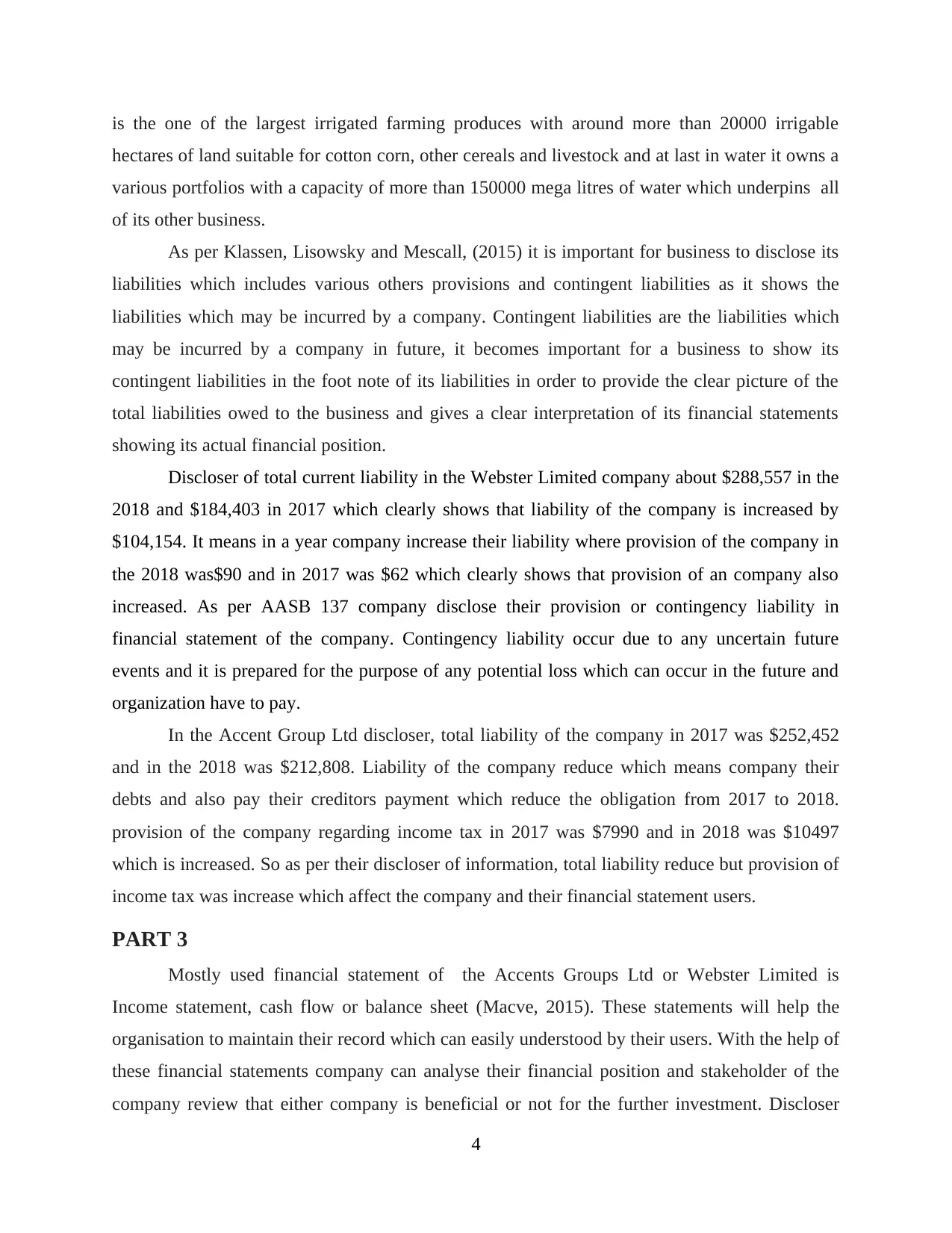
is the one of the largest irrigated farming produces with around more than 20000 irrigable
hectares of land suitable for cotton corn, other cereals and livestock and at last in water it owns a
various portfolios with a capacity of more than 150000 mega litres of water which underpins all
of its other business.
As per Klassen, Lisowsky and Mescall, (2015) it is important for business to disclose its
liabilities which includes various others provisions and contingent liabilities as it shows the
liabilities which may be incurred by a company. Contingent liabilities are the liabilities which
may be incurred by a company in future, it becomes important for a business to show its
contingent liabilities in the foot note of its liabilities in order to provide the clear picture of the
total liabilities owed to the business and gives a clear interpretation of its financial statements
showing its actual financial position.
Discloser of total current liability in the Webster Limited company about $288,557 in the
2018 and $184,403 in 2017 which clearly shows that liability of the company is increased by
$104,154. It means in a year company increase their liability where provision of the company in
the 2018 was$90 and in 2017 was $62 which clearly shows that provision of an company also
increased. As per AASB 137 company disclose their provision or contingency liability in
financial statement of the company. Contingency liability occur due to any uncertain future
events and it is prepared for the purpose of any potential loss which can occur in the future and
organization have to pay.
In the Accent Group Ltd discloser, total liability of the company in 2017 was $252,452
and in the 2018 was $212,808. Liability of the company reduce which means company their
debts and also pay their creditors payment which reduce the obligation from 2017 to 2018.
provision of the company regarding income tax in 2017 was $7990 and in 2018 was $10497
which is increased. So as per their discloser of information, total liability reduce but provision of
income tax was increase which affect the company and their financial statement users.
PART 3
Mostly used financial statement of the Accents Groups Ltd or Webster Limited is
Income statement, cash flow or balance sheet (Macve, 2015). These statements will help the
organisation to maintain their record which can easily understood by their users. With the help of
these financial statements company can analyse their financial position and stakeholder of the
company review that either company is beneficial or not for the further investment. Discloser
4
hectares of land suitable for cotton corn, other cereals and livestock and at last in water it owns a
various portfolios with a capacity of more than 150000 mega litres of water which underpins all
of its other business.
As per Klassen, Lisowsky and Mescall, (2015) it is important for business to disclose its
liabilities which includes various others provisions and contingent liabilities as it shows the
liabilities which may be incurred by a company. Contingent liabilities are the liabilities which
may be incurred by a company in future, it becomes important for a business to show its
contingent liabilities in the foot note of its liabilities in order to provide the clear picture of the
total liabilities owed to the business and gives a clear interpretation of its financial statements
showing its actual financial position.
Discloser of total current liability in the Webster Limited company about $288,557 in the
2018 and $184,403 in 2017 which clearly shows that liability of the company is increased by
$104,154. It means in a year company increase their liability where provision of the company in
the 2018 was$90 and in 2017 was $62 which clearly shows that provision of an company also
increased. As per AASB 137 company disclose their provision or contingency liability in
financial statement of the company. Contingency liability occur due to any uncertain future
events and it is prepared for the purpose of any potential loss which can occur in the future and
organization have to pay.
In the Accent Group Ltd discloser, total liability of the company in 2017 was $252,452
and in the 2018 was $212,808. Liability of the company reduce which means company their
debts and also pay their creditors payment which reduce the obligation from 2017 to 2018.
provision of the company regarding income tax in 2017 was $7990 and in 2018 was $10497
which is increased. So as per their discloser of information, total liability reduce but provision of
income tax was increase which affect the company and their financial statement users.
PART 3
Mostly used financial statement of the Accents Groups Ltd or Webster Limited is
Income statement, cash flow or balance sheet (Macve, 2015). These statements will help the
organisation to maintain their record which can easily understood by their users. With the help of
these financial statements company can analyse their financial position and stakeholder of the
company review that either company is beneficial or not for the further investment. Discloser
4
Paraphrase This Document
Need a fresh take? Get an instant paraphrase of this document with our AI Paraphraser
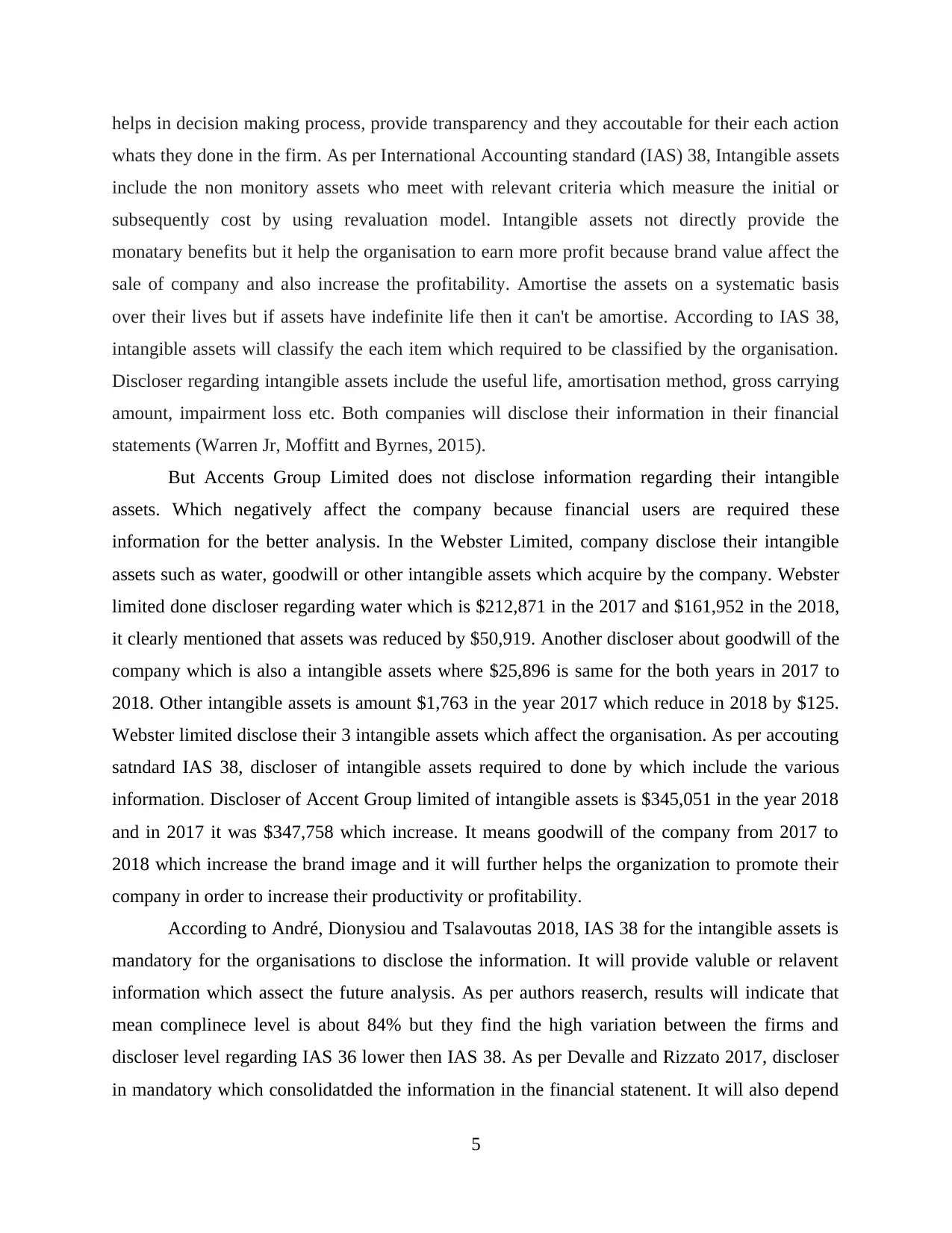
helps in decision making process, provide transparency and they accoutable for their each action
whats they done in the firm. As per International Accounting standard (IAS) 38, Intangible assets
include the non monitory assets who meet with relevant criteria which measure the initial or
subsequently cost by using revaluation model. Intangible assets not directly provide the
monatary benefits but it help the organisation to earn more profit because brand value affect the
sale of company and also increase the profitability. Amortise the assets on a systematic basis
over their lives but if assets have indefinite life then it can't be amortise. According to IAS 38,
intangible assets will classify the each item which required to be classified by the organisation.
Discloser regarding intangible assets include the useful life, amortisation method, gross carrying
amount, impairment loss etc. Both companies will disclose their information in their financial
statements (Warren Jr, Moffitt and Byrnes, 2015).
But Accents Group Limited does not disclose information regarding their intangible
assets. Which negatively affect the company because financial users are required these
information for the better analysis. In the Webster Limited, company disclose their intangible
assets such as water, goodwill or other intangible assets which acquire by the company. Webster
limited done discloser regarding water which is $212,871 in the 2017 and $161,952 in the 2018,
it clearly mentioned that assets was reduced by $50,919. Another discloser about goodwill of the
company which is also a intangible assets where $25,896 is same for the both years in 2017 to
2018. Other intangible assets is amount $1,763 in the year 2017 which reduce in 2018 by $125.
Webster limited disclose their 3 intangible assets which affect the organisation. As per accouting
satndard IAS 38, discloser of intangible assets required to done by which include the various
information. Discloser of Accent Group limited of intangible assets is $345,051 in the year 2018
and in 2017 it was $347,758 which increase. It means goodwill of the company from 2017 to
2018 which increase the brand image and it will further helps the organization to promote their
company in order to increase their productivity or profitability.
According to André, Dionysiou and Tsalavoutas 2018, IAS 38 for the intangible assets is
mandatory for the organisations to disclose the information. It will provide valuble or relavent
information which assect the future analysis. As per authors reaserch, results will indicate that
mean complinece level is about 84% but they find the high variation between the firms and
discloser level regarding IAS 36 lower then IAS 38. As per Devalle and Rizzato 2017, discloser
in mandatory which consolidatded the information in the financial statenent. It will also depend
5
whats they done in the firm. As per International Accounting standard (IAS) 38, Intangible assets
include the non monitory assets who meet with relevant criteria which measure the initial or
subsequently cost by using revaluation model. Intangible assets not directly provide the
monatary benefits but it help the organisation to earn more profit because brand value affect the
sale of company and also increase the profitability. Amortise the assets on a systematic basis
over their lives but if assets have indefinite life then it can't be amortise. According to IAS 38,
intangible assets will classify the each item which required to be classified by the organisation.
Discloser regarding intangible assets include the useful life, amortisation method, gross carrying
amount, impairment loss etc. Both companies will disclose their information in their financial
statements (Warren Jr, Moffitt and Byrnes, 2015).
But Accents Group Limited does not disclose information regarding their intangible
assets. Which negatively affect the company because financial users are required these
information for the better analysis. In the Webster Limited, company disclose their intangible
assets such as water, goodwill or other intangible assets which acquire by the company. Webster
limited done discloser regarding water which is $212,871 in the 2017 and $161,952 in the 2018,
it clearly mentioned that assets was reduced by $50,919. Another discloser about goodwill of the
company which is also a intangible assets where $25,896 is same for the both years in 2017 to
2018. Other intangible assets is amount $1,763 in the year 2017 which reduce in 2018 by $125.
Webster limited disclose their 3 intangible assets which affect the organisation. As per accouting
satndard IAS 38, discloser of intangible assets required to done by which include the various
information. Discloser of Accent Group limited of intangible assets is $345,051 in the year 2018
and in 2017 it was $347,758 which increase. It means goodwill of the company from 2017 to
2018 which increase the brand image and it will further helps the organization to promote their
company in order to increase their productivity or profitability.
According to André, Dionysiou and Tsalavoutas 2018, IAS 38 for the intangible assets is
mandatory for the organisations to disclose the information. It will provide valuble or relavent
information which assect the future analysis. As per authors reaserch, results will indicate that
mean complinece level is about 84% but they find the high variation between the firms and
discloser level regarding IAS 36 lower then IAS 38. As per Devalle and Rizzato 2017, discloser
in mandatory which consolidatded the information in the financial statenent. It will also depend
5
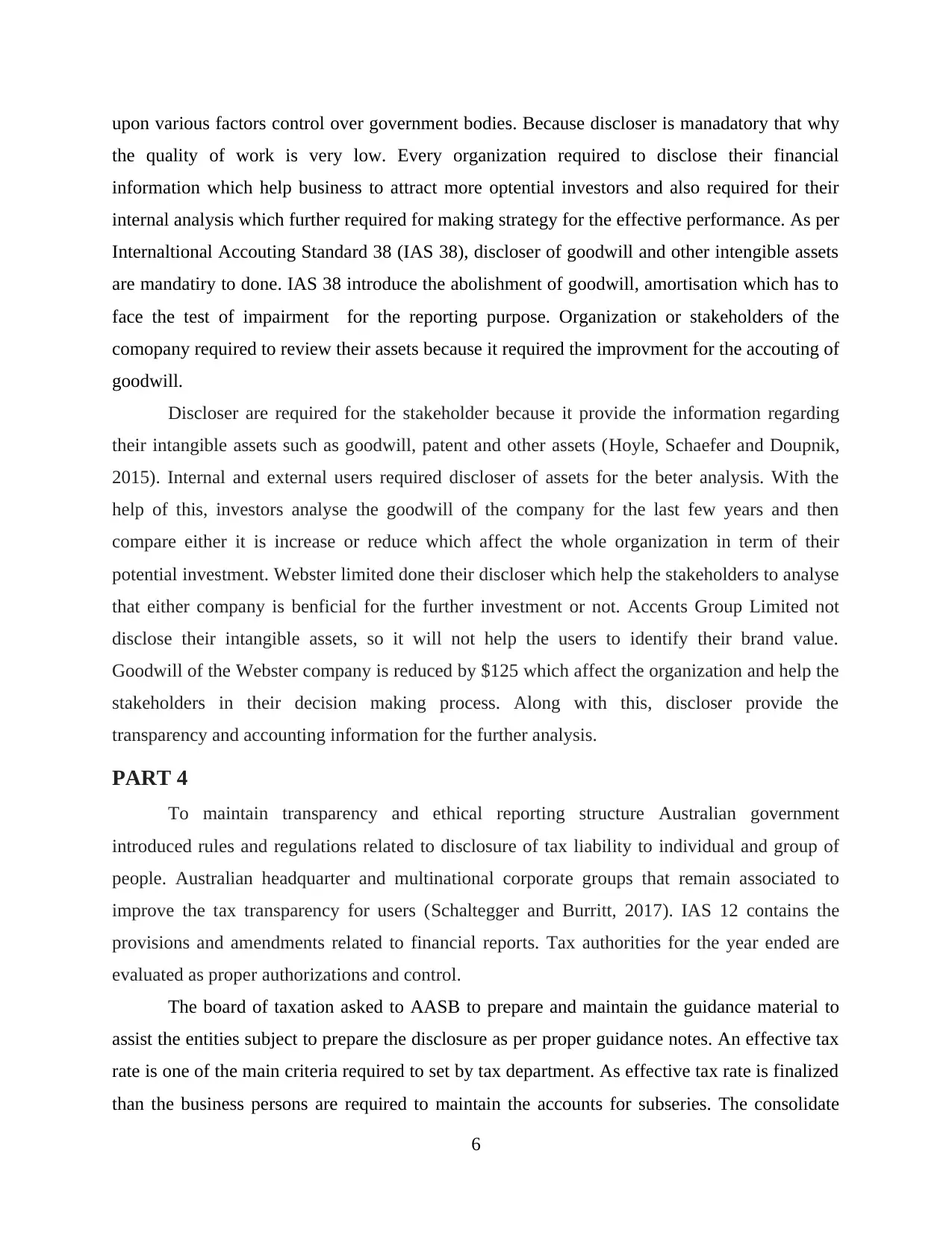
upon various factors control over government bodies. Because discloser is manadatory that why
the quality of work is very low. Every organization required to disclose their financial
information which help business to attract more optential investors and also required for their
internal analysis which further required for making strategy for the effective performance. As per
Internaltional Accouting Standard 38 (IAS 38), discloser of goodwill and other intengible assets
are mandatiry to done. IAS 38 introduce the abolishment of goodwill, amortisation which has to
face the test of impairment for the reporting purpose. Organization or stakeholders of the
comopany required to review their assets because it required the improvment for the accouting of
goodwill.
Discloser are required for the stakeholder because it provide the information regarding
their intangible assets such as goodwill, patent and other assets (Hoyle, Schaefer and Doupnik,
2015). Internal and external users required discloser of assets for the beter analysis. With the
help of this, investors analyse the goodwill of the company for the last few years and then
compare either it is increase or reduce which affect the whole organization in term of their
potential investment. Webster limited done their discloser which help the stakeholders to analyse
that either company is benficial for the further investment or not. Accents Group Limited not
disclose their intangible assets, so it will not help the users to identify their brand value.
Goodwill of the Webster company is reduced by $125 which affect the organization and help the
stakeholders in their decision making process. Along with this, discloser provide the
transparency and accounting information for the further analysis.
PART 4
To maintain transparency and ethical reporting structure Australian government
introduced rules and regulations related to disclosure of tax liability to individual and group of
people. Australian headquarter and multinational corporate groups that remain associated to
improve the tax transparency for users (Schaltegger and Burritt, 2017). IAS 12 contains the
provisions and amendments related to financial reports. Tax authorities for the year ended are
evaluated as proper authorizations and control.
The board of taxation asked to AASB to prepare and maintain the guidance material to
assist the entities subject to prepare the disclosure as per proper guidance notes. An effective tax
rate is one of the main criteria required to set by tax department. As effective tax rate is finalized
than the business persons are required to maintain the accounts for subseries. The consolidate
6
the quality of work is very low. Every organization required to disclose their financial
information which help business to attract more optential investors and also required for their
internal analysis which further required for making strategy for the effective performance. As per
Internaltional Accouting Standard 38 (IAS 38), discloser of goodwill and other intengible assets
are mandatiry to done. IAS 38 introduce the abolishment of goodwill, amortisation which has to
face the test of impairment for the reporting purpose. Organization or stakeholders of the
comopany required to review their assets because it required the improvment for the accouting of
goodwill.
Discloser are required for the stakeholder because it provide the information regarding
their intangible assets such as goodwill, patent and other assets (Hoyle, Schaefer and Doupnik,
2015). Internal and external users required discloser of assets for the beter analysis. With the
help of this, investors analyse the goodwill of the company for the last few years and then
compare either it is increase or reduce which affect the whole organization in term of their
potential investment. Webster limited done their discloser which help the stakeholders to analyse
that either company is benficial for the further investment or not. Accents Group Limited not
disclose their intangible assets, so it will not help the users to identify their brand value.
Goodwill of the Webster company is reduced by $125 which affect the organization and help the
stakeholders in their decision making process. Along with this, discloser provide the
transparency and accounting information for the further analysis.
PART 4
To maintain transparency and ethical reporting structure Australian government
introduced rules and regulations related to disclosure of tax liability to individual and group of
people. Australian headquarter and multinational corporate groups that remain associated to
improve the tax transparency for users (Schaltegger and Burritt, 2017). IAS 12 contains the
provisions and amendments related to financial reports. Tax authorities for the year ended are
evaluated as proper authorizations and control.
The board of taxation asked to AASB to prepare and maintain the guidance material to
assist the entities subject to prepare the disclosure as per proper guidance notes. An effective tax
rate is one of the main criteria required to set by tax department. As effective tax rate is finalized
than the business persons are required to maintain the accounts for subseries. The consolidate
6
⊘ This is a preview!⊘
Do you want full access?
Subscribe today to unlock all pages.

Trusted by 1+ million students worldwide
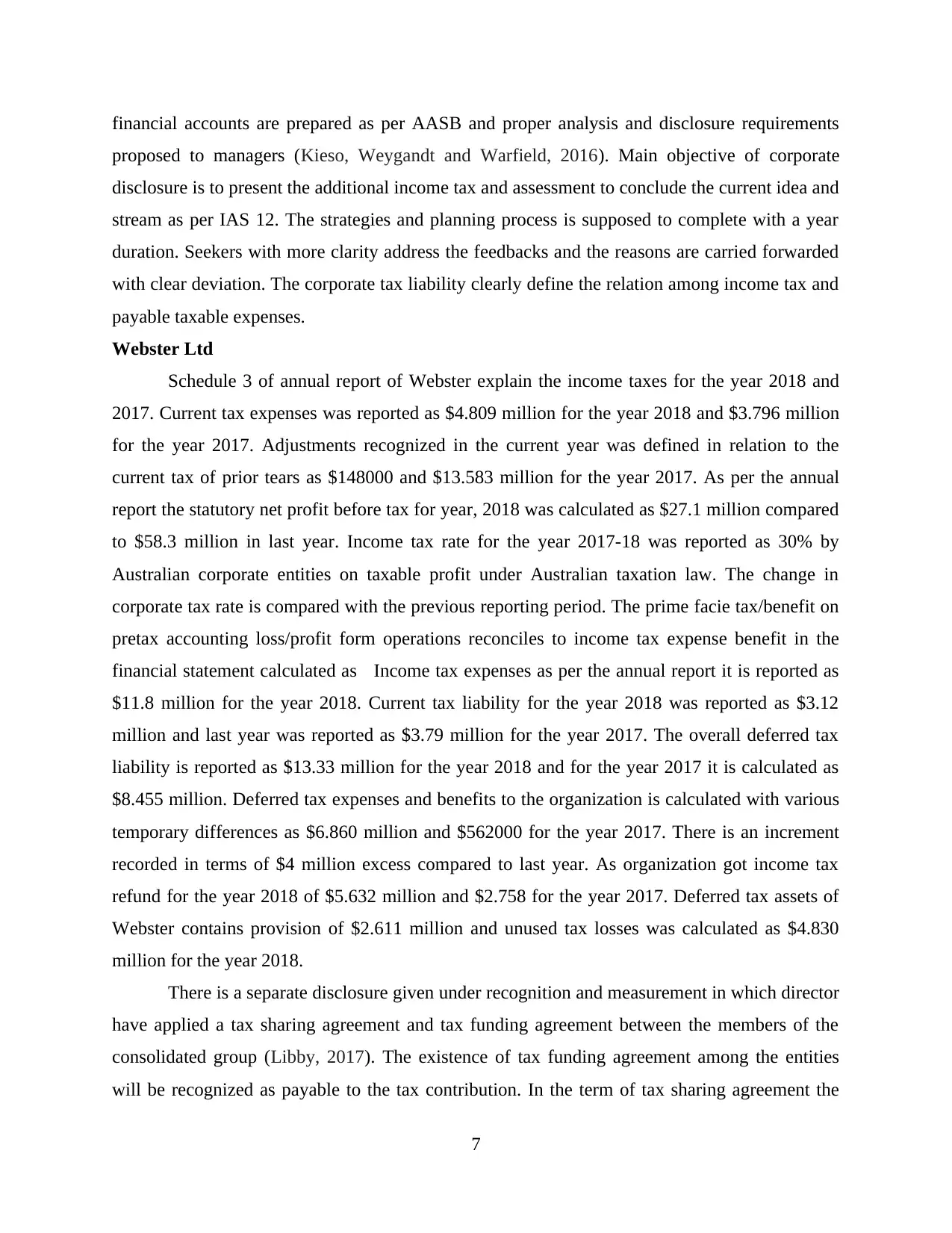
financial accounts are prepared as per AASB and proper analysis and disclosure requirements
proposed to managers (Kieso, Weygandt and Warfield, 2016). Main objective of corporate
disclosure is to present the additional income tax and assessment to conclude the current idea and
stream as per IAS 12. The strategies and planning process is supposed to complete with a year
duration. Seekers with more clarity address the feedbacks and the reasons are carried forwarded
with clear deviation. The corporate tax liability clearly define the relation among income tax and
payable taxable expenses.
Webster Ltd
Schedule 3 of annual report of Webster explain the income taxes for the year 2018 and
2017. Current tax expenses was reported as $4.809 million for the year 2018 and $3.796 million
for the year 2017. Adjustments recognized in the current year was defined in relation to the
current tax of prior tears as $148000 and $13.583 million for the year 2017. As per the annual
report the statutory net profit before tax for year, 2018 was calculated as $27.1 million compared
to $58.3 million in last year. Income tax rate for the year 2017-18 was reported as 30% by
Australian corporate entities on taxable profit under Australian taxation law. The change in
corporate tax rate is compared with the previous reporting period. The prime facie tax/benefit on
pretax accounting loss/profit form operations reconciles to income tax expense benefit in the
financial statement calculated as Income tax expenses as per the annual report it is reported as
$11.8 million for the year 2018. Current tax liability for the year 2018 was reported as $3.12
million and last year was reported as $3.79 million for the year 2017. The overall deferred tax
liability is reported as $13.33 million for the year 2018 and for the year 2017 it is calculated as
$8.455 million. Deferred tax expenses and benefits to the organization is calculated with various
temporary differences as $6.860 million and $562000 for the year 2017. There is an increment
recorded in terms of $4 million excess compared to last year. As organization got income tax
refund for the year 2018 of $5.632 million and $2.758 for the year 2017. Deferred tax assets of
Webster contains provision of $2.611 million and unused tax losses was calculated as $4.830
million for the year 2018.
There is a separate disclosure given under recognition and measurement in which director
have applied a tax sharing agreement and tax funding agreement between the members of the
consolidated group (Libby, 2017). The existence of tax funding agreement among the entities
will be recognized as payable to the tax contribution. In the term of tax sharing agreement the
7
proposed to managers (Kieso, Weygandt and Warfield, 2016). Main objective of corporate
disclosure is to present the additional income tax and assessment to conclude the current idea and
stream as per IAS 12. The strategies and planning process is supposed to complete with a year
duration. Seekers with more clarity address the feedbacks and the reasons are carried forwarded
with clear deviation. The corporate tax liability clearly define the relation among income tax and
payable taxable expenses.
Webster Ltd
Schedule 3 of annual report of Webster explain the income taxes for the year 2018 and
2017. Current tax expenses was reported as $4.809 million for the year 2018 and $3.796 million
for the year 2017. Adjustments recognized in the current year was defined in relation to the
current tax of prior tears as $148000 and $13.583 million for the year 2017. As per the annual
report the statutory net profit before tax for year, 2018 was calculated as $27.1 million compared
to $58.3 million in last year. Income tax rate for the year 2017-18 was reported as 30% by
Australian corporate entities on taxable profit under Australian taxation law. The change in
corporate tax rate is compared with the previous reporting period. The prime facie tax/benefit on
pretax accounting loss/profit form operations reconciles to income tax expense benefit in the
financial statement calculated as Income tax expenses as per the annual report it is reported as
$11.8 million for the year 2018. Current tax liability for the year 2018 was reported as $3.12
million and last year was reported as $3.79 million for the year 2017. The overall deferred tax
liability is reported as $13.33 million for the year 2018 and for the year 2017 it is calculated as
$8.455 million. Deferred tax expenses and benefits to the organization is calculated with various
temporary differences as $6.860 million and $562000 for the year 2017. There is an increment
recorded in terms of $4 million excess compared to last year. As organization got income tax
refund for the year 2018 of $5.632 million and $2.758 for the year 2017. Deferred tax assets of
Webster contains provision of $2.611 million and unused tax losses was calculated as $4.830
million for the year 2018.
There is a separate disclosure given under recognition and measurement in which director
have applied a tax sharing agreement and tax funding agreement between the members of the
consolidated group (Libby, 2017). The existence of tax funding agreement among the entities
will be recognized as payable to the tax contribution. In the term of tax sharing agreement the
7
Paraphrase This Document
Need a fresh take? Get an instant paraphrase of this document with our AI Paraphraser
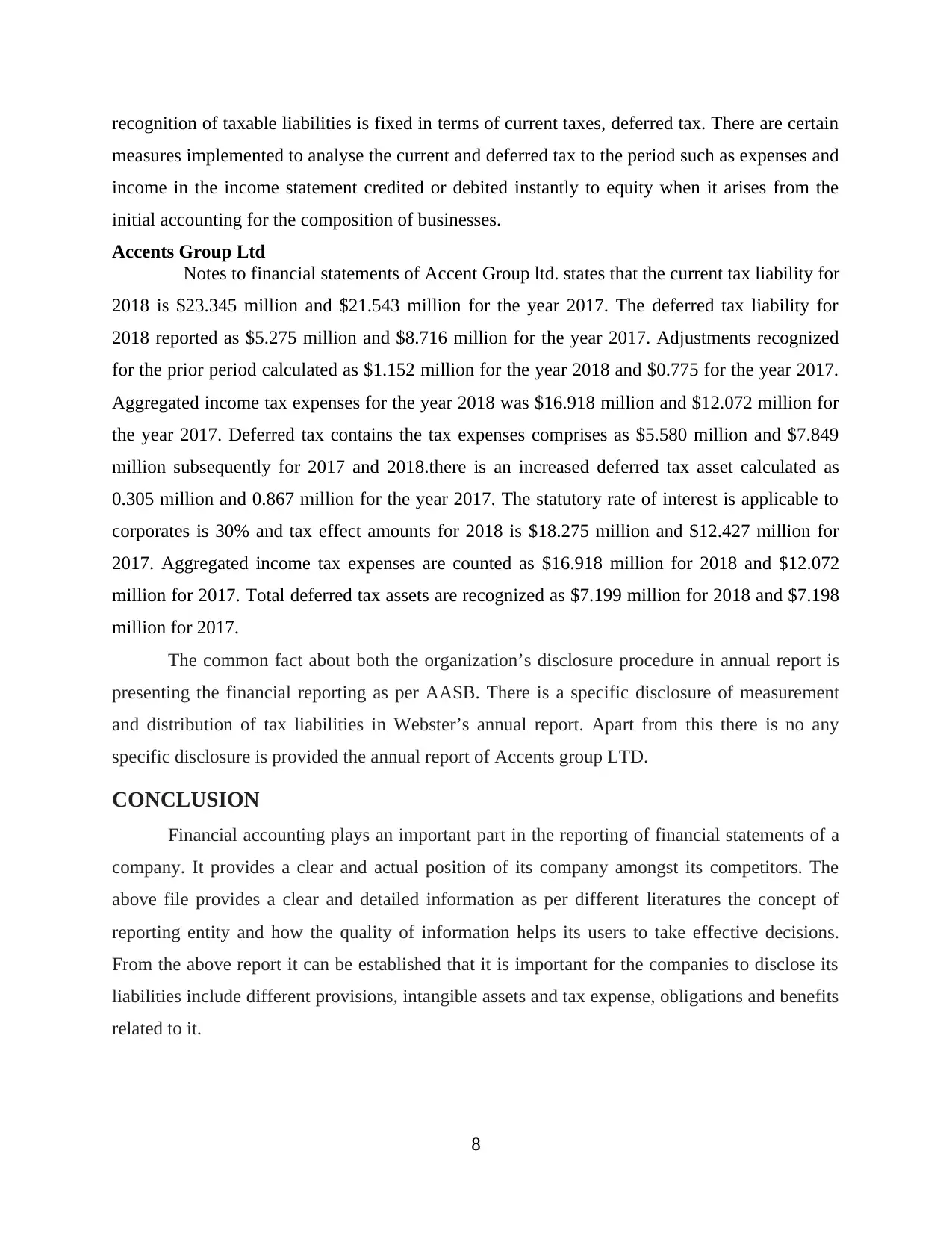
recognition of taxable liabilities is fixed in terms of current taxes, deferred tax. There are certain
measures implemented to analyse the current and deferred tax to the period such as expenses and
income in the income statement credited or debited instantly to equity when it arises from the
initial accounting for the composition of businesses.
Accents Group Ltd
Notes to financial statements of Accent Group ltd. states that the current tax liability for
2018 is $23.345 million and $21.543 million for the year 2017. The deferred tax liability for
2018 reported as $5.275 million and $8.716 million for the year 2017. Adjustments recognized
for the prior period calculated as $1.152 million for the year 2018 and $0.775 for the year 2017.
Aggregated income tax expenses for the year 2018 was $16.918 million and $12.072 million for
the year 2017. Deferred tax contains the tax expenses comprises as $5.580 million and $7.849
million subsequently for 2017 and 2018.there is an increased deferred tax asset calculated as
0.305 million and 0.867 million for the year 2017. The statutory rate of interest is applicable to
corporates is 30% and tax effect amounts for 2018 is $18.275 million and $12.427 million for
2017. Aggregated income tax expenses are counted as $16.918 million for 2018 and $12.072
million for 2017. Total deferred tax assets are recognized as $7.199 million for 2018 and $7.198
million for 2017.
The common fact about both the organization’s disclosure procedure in annual report is
presenting the financial reporting as per AASB. There is a specific disclosure of measurement
and distribution of tax liabilities in Webster’s annual report. Apart from this there is no any
specific disclosure is provided the annual report of Accents group LTD.
CONCLUSION
Financial accounting plays an important part in the reporting of financial statements of a
company. It provides a clear and actual position of its company amongst its competitors. The
above file provides a clear and detailed information as per different literatures the concept of
reporting entity and how the quality of information helps its users to take effective decisions.
From the above report it can be established that it is important for the companies to disclose its
liabilities include different provisions, intangible assets and tax expense, obligations and benefits
related to it.
8
measures implemented to analyse the current and deferred tax to the period such as expenses and
income in the income statement credited or debited instantly to equity when it arises from the
initial accounting for the composition of businesses.
Accents Group Ltd
Notes to financial statements of Accent Group ltd. states that the current tax liability for
2018 is $23.345 million and $21.543 million for the year 2017. The deferred tax liability for
2018 reported as $5.275 million and $8.716 million for the year 2017. Adjustments recognized
for the prior period calculated as $1.152 million for the year 2018 and $0.775 for the year 2017.
Aggregated income tax expenses for the year 2018 was $16.918 million and $12.072 million for
the year 2017. Deferred tax contains the tax expenses comprises as $5.580 million and $7.849
million subsequently for 2017 and 2018.there is an increased deferred tax asset calculated as
0.305 million and 0.867 million for the year 2017. The statutory rate of interest is applicable to
corporates is 30% and tax effect amounts for 2018 is $18.275 million and $12.427 million for
2017. Aggregated income tax expenses are counted as $16.918 million for 2018 and $12.072
million for 2017. Total deferred tax assets are recognized as $7.199 million for 2018 and $7.198
million for 2017.
The common fact about both the organization’s disclosure procedure in annual report is
presenting the financial reporting as per AASB. There is a specific disclosure of measurement
and distribution of tax liabilities in Webster’s annual report. Apart from this there is no any
specific disclosure is provided the annual report of Accents group LTD.
CONCLUSION
Financial accounting plays an important part in the reporting of financial statements of a
company. It provides a clear and actual position of its company amongst its competitors. The
above file provides a clear and detailed information as per different literatures the concept of
reporting entity and how the quality of information helps its users to take effective decisions.
From the above report it can be established that it is important for the companies to disclose its
liabilities include different provisions, intangible assets and tax expense, obligations and benefits
related to it.
8
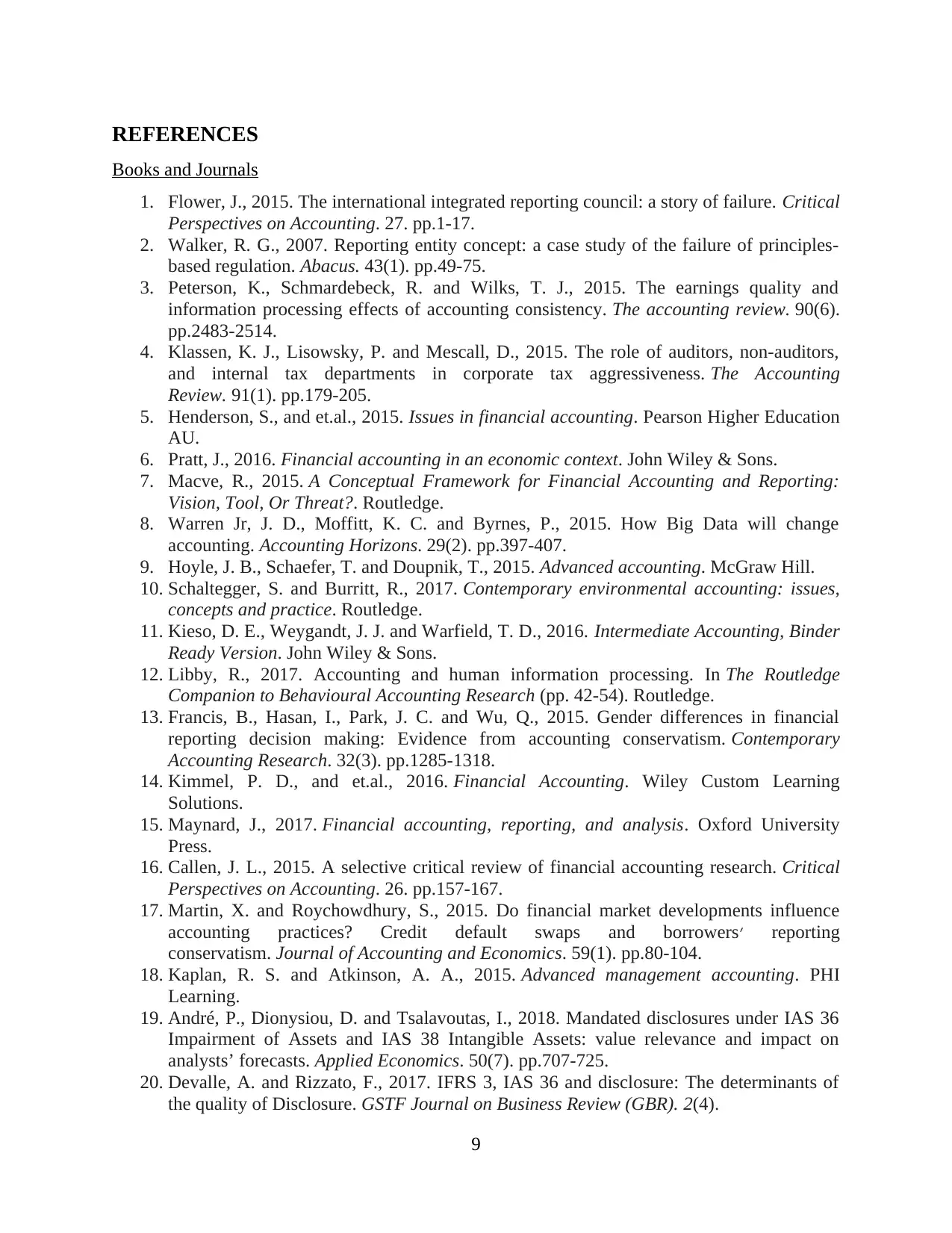
REFERENCES
Books and Journals
1. Flower, J., 2015. The international integrated reporting council: a story of failure. Critical
Perspectives on Accounting. 27. pp.1-17.
2. Walker, R. G., 2007. Reporting entity concept: a case study of the failure of principles‐
based regulation. Abacus. 43(1). pp.49-75.
3. Peterson, K., Schmardebeck, R. and Wilks, T. J., 2015. The earnings quality and
information processing effects of accounting consistency. The accounting review. 90(6).
pp.2483-2514.
4. Klassen, K. J., Lisowsky, P. and Mescall, D., 2015. The role of auditors, non-auditors,
and internal tax departments in corporate tax aggressiveness. The Accounting
Review. 91(1). pp.179-205.
5. Henderson, S., and et.al., 2015. Issues in financial accounting. Pearson Higher Education
AU.
6. Pratt, J., 2016. Financial accounting in an economic context. John Wiley & Sons.
7. Macve, R., 2015. A Conceptual Framework for Financial Accounting and Reporting:
Vision, Tool, Or Threat?. Routledge.
8. Warren Jr, J. D., Moffitt, K. C. and Byrnes, P., 2015. How Big Data will change
accounting. Accounting Horizons. 29(2). pp.397-407.
9. Hoyle, J. B., Schaefer, T. and Doupnik, T., 2015. Advanced accounting. McGraw Hill.
10. Schaltegger, S. and Burritt, R., 2017. Contemporary environmental accounting: issues,
concepts and practice. Routledge.
11. Kieso, D. E., Weygandt, J. J. and Warfield, T. D., 2016. Intermediate Accounting, Binder
Ready Version. John Wiley & Sons.
12. Libby, R., 2017. Accounting and human information processing. In The Routledge
Companion to Behavioural Accounting Research (pp. 42-54). Routledge.
13. Francis, B., Hasan, I., Park, J. C. and Wu, Q., 2015. Gender differences in financial
reporting decision making: Evidence from accounting conservatism. Contemporary
Accounting Research. 32(3). pp.1285-1318.
14. Kimmel, P. D., and et.al., 2016. Financial Accounting. Wiley Custom Learning
Solutions.
15. Maynard, J., 2017. Financial accounting, reporting, and analysis. Oxford University
Press.
16. Callen, J. L., 2015. A selective critical review of financial accounting research. Critical
Perspectives on Accounting. 26. pp.157-167.
17. Martin, X. and Roychowdhury, S., 2015. Do financial market developments influence
accounting practices? Credit default swaps and borrowers׳ reporting
conservatism. Journal of Accounting and Economics. 59(1). pp.80-104.
18. Kaplan, R. S. and Atkinson, A. A., 2015. Advanced management accounting. PHI
Learning.
19. André, P., Dionysiou, D. and Tsalavoutas, I., 2018. Mandated disclosures under IAS 36
Impairment of Assets and IAS 38 Intangible Assets: value relevance and impact on
analysts’ forecasts. Applied Economics. 50(7). pp.707-725.
20. Devalle, A. and Rizzato, F., 2017. IFRS 3, IAS 36 and disclosure: The determinants of
the quality of Disclosure. GSTF Journal on Business Review (GBR). 2(4).
9
Books and Journals
1. Flower, J., 2015. The international integrated reporting council: a story of failure. Critical
Perspectives on Accounting. 27. pp.1-17.
2. Walker, R. G., 2007. Reporting entity concept: a case study of the failure of principles‐
based regulation. Abacus. 43(1). pp.49-75.
3. Peterson, K., Schmardebeck, R. and Wilks, T. J., 2015. The earnings quality and
information processing effects of accounting consistency. The accounting review. 90(6).
pp.2483-2514.
4. Klassen, K. J., Lisowsky, P. and Mescall, D., 2015. The role of auditors, non-auditors,
and internal tax departments in corporate tax aggressiveness. The Accounting
Review. 91(1). pp.179-205.
5. Henderson, S., and et.al., 2015. Issues in financial accounting. Pearson Higher Education
AU.
6. Pratt, J., 2016. Financial accounting in an economic context. John Wiley & Sons.
7. Macve, R., 2015. A Conceptual Framework for Financial Accounting and Reporting:
Vision, Tool, Or Threat?. Routledge.
8. Warren Jr, J. D., Moffitt, K. C. and Byrnes, P., 2015. How Big Data will change
accounting. Accounting Horizons. 29(2). pp.397-407.
9. Hoyle, J. B., Schaefer, T. and Doupnik, T., 2015. Advanced accounting. McGraw Hill.
10. Schaltegger, S. and Burritt, R., 2017. Contemporary environmental accounting: issues,
concepts and practice. Routledge.
11. Kieso, D. E., Weygandt, J. J. and Warfield, T. D., 2016. Intermediate Accounting, Binder
Ready Version. John Wiley & Sons.
12. Libby, R., 2017. Accounting and human information processing. In The Routledge
Companion to Behavioural Accounting Research (pp. 42-54). Routledge.
13. Francis, B., Hasan, I., Park, J. C. and Wu, Q., 2015. Gender differences in financial
reporting decision making: Evidence from accounting conservatism. Contemporary
Accounting Research. 32(3). pp.1285-1318.
14. Kimmel, P. D., and et.al., 2016. Financial Accounting. Wiley Custom Learning
Solutions.
15. Maynard, J., 2017. Financial accounting, reporting, and analysis. Oxford University
Press.
16. Callen, J. L., 2015. A selective critical review of financial accounting research. Critical
Perspectives on Accounting. 26. pp.157-167.
17. Martin, X. and Roychowdhury, S., 2015. Do financial market developments influence
accounting practices? Credit default swaps and borrowers׳ reporting
conservatism. Journal of Accounting and Economics. 59(1). pp.80-104.
18. Kaplan, R. S. and Atkinson, A. A., 2015. Advanced management accounting. PHI
Learning.
19. André, P., Dionysiou, D. and Tsalavoutas, I., 2018. Mandated disclosures under IAS 36
Impairment of Assets and IAS 38 Intangible Assets: value relevance and impact on
analysts’ forecasts. Applied Economics. 50(7). pp.707-725.
20. Devalle, A. and Rizzato, F., 2017. IFRS 3, IAS 36 and disclosure: The determinants of
the quality of Disclosure. GSTF Journal on Business Review (GBR). 2(4).
9
⊘ This is a preview!⊘
Do you want full access?
Subscribe today to unlock all pages.

Trusted by 1+ million students worldwide
1 out of 13
Related Documents
Your All-in-One AI-Powered Toolkit for Academic Success.
+13062052269
info@desklib.com
Available 24*7 on WhatsApp / Email
![[object Object]](/_next/static/media/star-bottom.7253800d.svg)
Unlock your academic potential
Copyright © 2020–2025 A2Z Services. All Rights Reserved. Developed and managed by ZUCOL.





